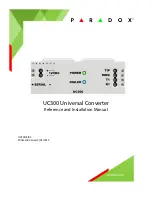
142
PARAMETERS
<Set point input calibration>
1. Apply the input voltage of 0% set point setting (e.g. 0V) to across terminals 2-5.
2. Make calibration using Pr. 902. At this time, enter the frequency which should be
output by the inverter at the deviation of 0% (e.g. 0Hz).
3. Apply the voltage of 100% set point setting (e.g. 5V) to across terminals 2-5.
4. Make calibration using Pr. 903. At this time, enter the frequency which should be
output by the inverter at the deviation of 100% (e.g. 60Hz).
<Detector output calibration>
1. Apply the output current of 0% detector setting (e.g. 4mA) across terminals 4-5.
2. Make calibration using Pr. 904.
3. Apply the output current of 100% detector setting (e.g. 20mA) across terminals 4-5.
4. Make calibration using Pr. 905.
Note: The frequencies set in Pr. 904 and Pr. 905 should be the same as set in Pr. 902
and Pr. 903.
The results of the above calibration are as shown below:
Note:1. Entering multi-speed (RH, RM, RL signal) or JOG operation will stop PID
control and start multi-speed or JOG operation.
2. When the terminal functions are changed using Pr. 190 to Pr. 192, the other
functions may be affected. Confirm the functions of the corresponding
terminals before making settings.
3. When you have chosen the PID control, the minimum frequency is as set in
Pr. 902 and the maximum frequency is as set in Pr. 903.
(The settings of Pr. 1 "maximum frequency" and Pr. 2 "minimum frequency"
are also valid.)
100
0
0
5
(V)
(%)
[Set point setting]
100
0
0
20 (mA)
(%)
4
[Detection value]
60
0
0
100
Deviation
(%)
[Manipulated variable]
Manipulated
variable(Hz)
M4500E.book 142 ページ 2005年2月22日 火曜日 午後5時7分
Summary of Contents for M4000E series
Page 11: ...MEMO ...
Page 23: ...12 MEMO ...
Page 55: ...44 MEMO ...
Page 173: ...162 MEMO ...
Page 199: ...188 MEMO ...
















































